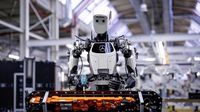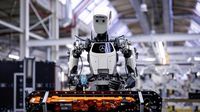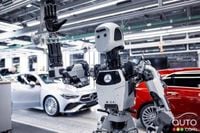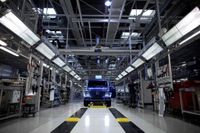If you're still gullible enough to take Elon Musk at his word, pivoting to AI and robotics will turn Tesla into a $5 trillion company, and he'll also eventually sell 20 billion humanoid robots. Before you know it, the world will be overrun with hardworking Tesla robots. At least in theory.
The latest photos show Tesla's robot once again canoodling with billionaire Kim Kardashian like a spoiled dilettante. Meanwhile, Mercedes-Benz already has honest, hard-working, salt-of-the-earth humanoid robots working in its Berlin-Marienfelde Digital Factory Campus.
Your move, Tesla. Instead of designing and building its own robots, Mercedes turned to Apptronik, a U.S. company that is already building and selling humanoid robots for use in commercial applications — sorry, horny incels. In a release, Mercedes calls Apptronik's first model, the Apollo, "one of world's most advanced commercial humanoid robots" and was apparently impressed enough to give the company "a low double-digit-million-euro investment" on top of buying its robots. That's somehow both a huge amount of money and also probably very little compared to what it actually cost to bring the Apollo to market.
While it's no secret that robots aren’t new to Mercedes—they've been utilizing automation since the 1970s—the Apollo robots aren't meant to replace factory workers just yet. Their main role is to transport components or modules to the production line for Mercedes-Benz's highly skilled production staff to assemble and conduct initial quality checks on components.
There's no doubt that these robots have the potential to ease some of the physical toll on human workers, especially given that they're now leveraging teleoperation processes and augmented reality to train their software for more complex tasks. It's an interesting development, especially as companies like Tesla continue to float grandiose promises regarding their own humanoid robots.
But one has to wonder whether the Tesla robots will be as effective as their competitors. The Apollo robots are set to gain more advanced skills and take on even more complicated jobs in the future. For now, they are actually contributing to production efforts rather than engaging in dramas or frivolities.
Ultimately, if Tesla ever wants to catch up in the humanoid robot space, it may need to teach its Optimus robot some work ethic. Right now, it seems to follow the stereotype of a nepo-baby failson, unable to grasp the hard work ethos that the Apollo robots epitomize.
Mercedes-Benz is laboring hard to develop robotics capabilities that can perform basic but essential tasks, while Tesla appears to be stuck in the background, resting on its founder's lofty visions.
In the growing industry of humanoid robotics, Mercedes-Benz stands alongside other notable players, including Honda, Hyundai, and BMW. These companies have all experimented with humanoid robots in various capacities. However, Tesla’s anticipated deployment of its own Optimus robot in factories may signal that the competition is far from over.
Recent reports indicate that Apptronik successfully raised $350 million in Series A funding to further develop the Apollo robot, along with securing a partnership with Google’s DeepMind to enhance the robot’s skills through AI improvements.
The humanoid robotics sector is burgeoning as companies begin to recognize the viability of these machines, which can provide a supportive role in manufacturing and logistics settings, helping tackle those repetitive or hazardous tasks.
Mercedes has already begun testing the Apollo model in locations such as its Digital Factory Campus in Berlin, with plans for additional trials slated for Kecskemet in Hungary. Producing a humanoid robot capable of executing jobs efficiently is a task companies find appealing, particularly as the potential for workforce optimization becomes apparent.
In a world increasingly driven by automation, the future of work may one day include a partnership between human intelligence and robotic efficiency, making the prospects of humanoid robots like Apollo critical for the shifting fabric of industry. As the industry advances, it remains to be seen whether Tesla can convince consumers and industry insiders alike that their ambitious plans for robotics and AI are grounded in reality rather than mere marketing hype.




